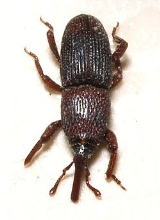
Sitophilus
Encyclopedia
Sitophilus is a cosmopolitan genus of weevil
s found on rice
, maize
and tamarind
. It has also been found on Chickpea
.
Notable species, the Rice weevil
, S. oryzae and the Maize weevil
(S. zeamais) both damage a variety of standing crops, and other stored cereals.
Pest status: A very serious major (primary) pest of stored rice and other cereals in the warmer parts of the world.
Weevil
A weevil is any beetle from the Curculionoidea superfamily. They are usually small, less than , and herbivorous. There are over 60,000 species in several families, mostly in the family Curculionidae...
s found on rice
Rice
Rice is the seed of the monocot plants Oryza sativa or Oryza glaberrima . As a cereal grain, it is the most important staple food for a large part of the world's human population, especially in East Asia, Southeast Asia, South Asia, the Middle East, and the West Indies...
, maize
Maize
Maize known in many English-speaking countries as corn or mielie/mealie, is a grain domesticated by indigenous peoples in Mesoamerica in prehistoric times. The leafy stalk produces ears which contain seeds called kernels. Though technically a grain, maize kernels are used in cooking as a vegetable...
and tamarind
Tamarind
Tamarind is a tree in the family Fabaceae. The genus Tamarindus is monotypic .-Origin:...
. It has also been found on Chickpea
Chickpea
The chickpea is a legume of the family Fabaceae, subfamily Faboideae...
.
Notable species, the Rice weevil
Rice weevil
The rice weevil is a serious stored product pest which attacks several economically important crops, including wheat, rice, and maize.- Description :...
, S. oryzae and the Maize weevil
Maize weevil
The maize weevil , known in the United States as the greater rice weevil, is a species of beetle in the family Curculionidae. It can be found in numerous tropical areas around the world, and in the United States, and is a major pest of maize...
(S. zeamais) both damage a variety of standing crops, and other stored cereals.
Distribution
The two species, Sitophilus oryzae and S. zeamais, are virtually cosmopolitan throughout the warmer parts of the world. In Europe they are replaced by the temperate Palaearctic species S. granarius which is distinguished by the punctate sculpturing on the prothorax and elytra, and by the fact that it is wingless and hence cannot fly.Life history
Identical to S. zeamais so far as is known, but preferably taking place in rice. Eggs are white and oval. The female lays the eggs inside the grain by chewing a minute hole in which each egg is deposited, followed by the sealing of the hole with a secretion. These eggs hatch into tiny grubs which stay and feed inside the grain and are responsible for most of the damage. Mature larvae are plump, legless and white, about 4 mm long. Pupation takes place inside the grain. The adult beetle emerges by biting a circular hole through outer layers of the grain. They are small brown weevils, virtually indistinguishable from each other, about 3.5-4.0 mm long with rostrum and thorax large and conspicuous. The elytra are uniformly dark brown. Each female is capable of laying 300-400 eggs, and the adults live for five to eight months and are capable fliers. The life-cycle is about five weeks at 30oC and 70% RH; optimum conditions for development are 27-31oC and more than 60% RH; below 17oC development ceases.Damage
The developing larva lives and feeds inside the grain hollowing it out in the process. In rice (the preferred host) the entire grain is usually destroyed by the time the adult emerges.Pest status: A very serious major (primary) pest of stored rice and other cereals in the warmer parts of the world.
Species
- Sitophilus granarius (wheat weevilWheat weevilWheat weevils , also known as grain weevils or granary weevils, occur all over the world and are a common pest in many places. They can cause significant damage to harvested grains that are being stored and may drastically decrease yields...
or granary weevil) - Sitophilus linearis (tamarind weevil)
- Sitophilus oryzae (rice weevilRice weevilThe rice weevil is a serious stored product pest which attacks several economically important crops, including wheat, rice, and maize.- Description :...
) - Sitophilus vateriae
- Sitophilus zeamais (maize weevilMaize weevilThe maize weevil , known in the United States as the greater rice weevil, is a species of beetle in the family Curculionidae. It can be found in numerous tropical areas around the world, and in the United States, and is a major pest of maize...
)
External links
- Obata H., Manabe A., Nakamura N., Onishi T. & Senba Y. (2011). "A New Light on the Evolution and Propagation of Prehistoric Grain Pests: The World's Oldest Maize Weevils Found in Jomon Potteries, Japan". PLoS ONEPLoS ONEPLoS ONE is an open access peer-reviewed scientific journal published by the Public Library of Science since 2006. It covers primary research from any discipline within science and medicine. All submissions go through an internal and external pre-publication peer review but are not excluded on the...
6(3): e14785. doi:10.1371/journal.pone.0014785.

